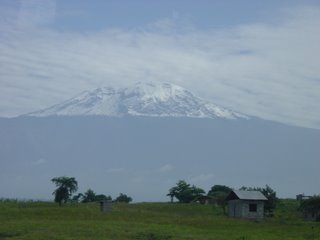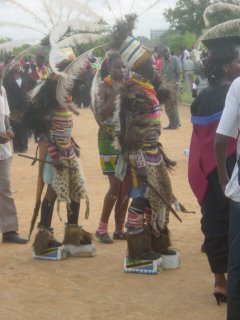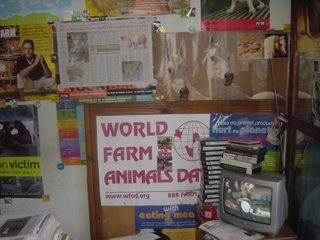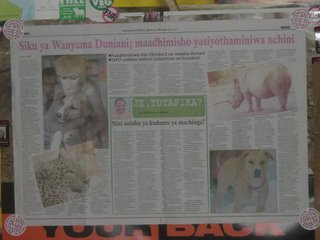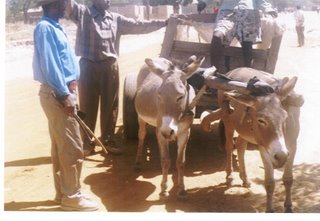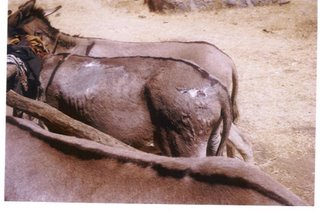Rift Valley fever {RVF}
OVERVIEW Rift Valley Fever (RVF), is a zoonosis (a disease which primarily affects animals, but occasionally causes disease in humans). It may cause severe disease in both animals and humans leading to high morbidity and mortality. The death of RVF-infected livestock often leads to substantial economic losses.
Since 1930, when the virus was first isolated during an investigation into an epidemic amongst sheep on a farm in the Rift Valley of Kenya, there have been outbreaks in sub-Saharan and North Africa. In 1997-98, there was a major outbreak in Kenya and Somalia. In September 2000, RVF was for the first time reported outside of the African Continent. Cases were confirmed in Saudi Arabia and Yemen. This virgin-soil epidemic in the Arabian Peninsula raises the threat of expansion into other parts of Asia and Europe.
Many different species of mosquitoes are vectors for the RVF virus. There is, therefore, a potential for epizootics (epidemics amongst animals) and associated human epidemics following the introduction of the virus into a new area where these vectors are present. This has been demonstrated in the past and remains a concern.
RVF VIRUS
The virus, which causes RVF, is a member of the Phlebovirus genus, one of the five genera in the family Bunyaviridae.
RVF VECTORS
• RVF virus is primarily spread amongst animals by the bite of infected mosquitoes.
• A wide variety of mosquito species may act as the vector for transmission of the RVF virus; in different regions a different species of mosquito may prove to be the predominant vector. In addition, the various vector species play differing roles in sustaining transmission of the virus.
• Aedes mosquitoes, for example, may acquire the virus from feeding on infected animals, and are capable of transovarial transmission (transmission of the virus from infected female mosquitoes to offspring via eggs), so new generations of infected mosquitoes may hatch from their eggs.
This provides a durable mechanism for maintaining the virus in nature, as the eggs of these mosquitoes may survive for periods of up to several years in dry conditions. During periods of inundation of larval habitats by rainfall, for example, in the rainy season, the eggs will hatch, and the mosquito population will increase and spread the virus to the animals on which they feed.
Previously uninfected Aedes and other species of mosquitoes will feed on infected, viraemic (virus circulating in the bloodstream) animals and thus amplify and perpetuate the outbreak by transmitting the virus to the animals on which they subsequently feed.
RVF VIRUS NON-HUMAN HOSTS
• Many types of animals may be infected with RVF, and disease may be severe in many domesticated animals including cattle, sheep, camels and goats. Sheep appear to be more susceptible than cattle and goats are less susceptible.
• Exotic breeds, which have been recently introduced into an endemic area, fare worse than breeds long adapted to local conditions.
• Animals of different ages also differ in their susceptibility to severe illness: over 90% of lambs infected with RVF die, whereas mortality amongst adult sheep can be as low as 10%.
• The abortion rate amongst pregnant, infected ewes is almost 100%. An epizootic (epidemic animal disease) of RVF is usually first manifested as a wave of unexplained abortions amongst livestock. This may signal the start of an epidemic.
TRANSMISSION TO HUMANS
• During epizootics, people may become infected with RVF either by being bitten by infected mosquitoes, or through contact with the blood, other body fluids or organs of infected animals.
• Such contact may occur during the care or slaughtering of infected animals, or possibly from the ingestion of raw milk.
• The virus may infect humans through inoculation (e.g., if the skin is broken, or through a wound from an infected knife), or through inhalation as an aerosol. The aerosol mode of transmission has also led to infection in laboratory workers
CLINICAL FEATURES
• The incubation period (interval from infection to onset of symptoms) of RVF varies from two to six days.
• There then follows an influenza-like illness, with sudden onset of fever, headache, myalgia (muscle pain) and backache. Some patients also develop neck stiffness, photophobia (the patient finds exposure to light uncomfortable) and vomiting; in these patients the disease, in the early stages, may be mistaken for meningitis.
• The symptoms of RVF usually last from four to seven days, after which time the immune response to infection becomes detectable with the appearance of IgM and IgG antibodies, and the disappearance of circulating virus from the bloodstream.
CLINICAL FEATURES OF SEVERE CASES
• While most human cases are relatively mild, a small proportion of patients develops a much more severe disease. This generally appears as one of several recognizable syndromes: eye disease, meningoencephalitis (inflammation of the brain and surrounding tissue) or haemorrhagic fever. The proportion of patients developing these three types of complications is about 0.5-2% for eye disease, and less than 1% for meningoencephalitis and haemorrhagic fever syndrome.
• The fever and other symptoms described in the preceding section, Clinical Features, may appear in association with eye disease, which characteristically manifests itself in retinal lesions. The onset of eye disease is usually one to three weeks after the first symptoms appear. When the lesions are in the macula, some degree of permanent visual loss will result. Death in patients with only ocular disease is uncommon.
• Another syndrome manifests itself with acute neurological disease, meningo-encephalitis. The onset of this syndrome is also usually one to three weeks after the first symptoms appear. Death in patients with only meningoencephalitis is uncommon.
• RVF may also manifest itself as haemorrhagic fever. Two to four days after the onset of illness, the patient shows evidence of severe liver disease, with jaundice and haemorrhagic phenomena, such as vomiting blood, passing blood in the faeces, developing a purpuric rash (a rash caused by bleeding in the skin), and bleeding from the gums. Patients with the RVF-haemorrhagic fever syndrome may remain viraemic for up to 10 days. The case-fatality rate for patients developing haemorrhagic disease is high at approximately 50%.
• Most fatalities occur in patients who have developed haemorrhagic fever. The total case fatality rate has varied widely in the various documented epidemics, but, overall, is less than 1%.
DIAGNOSIS AND TREATMENT
• Several approaches may be used in diagnosing acute RVF. Serological tests such as enzyme-linked immunoassay (the "ELISA" or "EIA" methods) may demonstrate the presence of specific IgM antibodies to the virus. The virus itself may be detected in blood during the viremia phase of illness or post-mortem tissues by a variety of techniques including virus propagation (in cell cultures or inoculated animals), antigen detection tests, and PCR, a molecular method for detecting the viral genome.
• Most human cases of RVF are relatively mild and of short duration, so will not require any specific treatment. For the more severe cases, the mainstay of treatment is general supportive therapy
PREVENTION AND CONTROL
• RVF can be prevented by a sustained program of animal vaccination. Both live, attenuated, and killed vaccines have been developed for veterinary use. The live vaccine requires only one dose and produces long-lived immunity, but the presently-available vaccine may cause abortion if given to pregnant animals. The killed vaccines do not cause these unwanted effects, but multiple doses must be given to produce protective immunity. This may prove problematic in endemic areas.
• An inactivated vaccine has been developed for human use. This vaccine is not licensed and is not commercially available, but has been used experimentally to protect veterinary and laboratory personnel at high risk of exposure to RVF. Other candidate vaccines are under investigation.
• The risk of transmission from infected blood or tissues exists for people working with infected animals or people during an outbreak. Gloves and other appropriate protective clothing should be worn, and care taken when handling sick animals or their tissues. Healthcare workers looking after patients with suspected or confirmed RVF should employ universal precautions when taking and processing specimens from patients. Hospitalized patients should be nursed using barrier techniques. As noted above, laboratory workers are at risk, so samples taken for diagnosis from suspected human and animal cases of RVF should be handled by trained staff and processed in suitably equipped laboratories.
• Other approaches to the control of disease involve protection from and control of the mosquito vectors. Personal protection is important and effective. Where appropriate, individuals should wear protective clothing, such as long shirts and trousers, use bednets and insect repellent, and avoid outdoor activity at peak biting times of the vector species. Measures to control mosquitoes during outbreaks, e.g., use of insecticides, are effective if conditions allow access to mosquito breeding sites.
New systems that monitor variations in climatic conditions are being applied to give advance warning of impending outbreaks by signalling events which may lead to increases in mosquito numbers. Such warnings will allow authorities to implement measures to avert an impending epidemic.
A non profit registered animal Protection organization from the mainland of the United Republic of Tanzania. .
TAPO Logo

Monday, April 02, 2007
Saturday, March 31, 2007
Arusha Dogs

In Arusha Tanzania There is many street dogs roaming in the streets of the Arusha City, whereby due to overpopulation of these Animals the Arusha Municipal Council decrease them by shooting with gun. This is cruelty in the Tourists city.
TAPO will under take the Arusha dogs rehabilation program which will take all street dogs housing them, treat them, and train them to be used in many works like guarding.
Please support us in order to launch this program
Thursday, March 29, 2007
Killings of Innocent Cats
Wednesday, February 28, 2007
Support Monduli Donkeys Welfares Project
Wednesday, January 10, 2007
Thursday, December 07, 2006
Ngozi za Wanyama na Utamaduni Tanzania
Thursday, November 16, 2006
Makazi Ya Viumbe

Makaza ya viumbe wengin hasa warukao hutegemea hasa kuishi kwenye miti na majani kwa kipindi chao chote cha maisha yao.
Baadhi ya watu wamekuwa wakikata miti hovyo na kuchoma majani kila sehemu ya nchi yetu na kitendo hiki ni ukatili wa hali ya juu kwa viumbe hao, watu wanatakiwa kuwa na huruma na kufikiria kila jambo wanalotenda
Humane Education

Humane Education is key factor for decreasing violence among young people, we need to educates young peoples to understand and to care about human being and animal, that all are creatures and need the right to live.
Teaching humane education in Tanzania is not famous despite the peace song the country leaders speaking, if we can teach all people concerning the caring of others we can keep the country of Tanzania in more safe nation to live in the world
Saturday, November 11, 2006
Make Donation
Please make donation to our organization in order to make us works by donating anything through the following address
Tanzania Animals Protection Org
Box 62921
Dar es salaam
Tanzania
Email;tap_org@yahoo.com
Tell; +255 0756 027419
Tanzania Animals Protection Org
Box 62921
Dar es salaam
Tanzania
Email;tap_org@yahoo.com
Tell; +255 0756 027419
Sunday, November 05, 2006
Thursday, November 02, 2006
Mateso ya Ng'ombe Pugu Mnadani
Wanyama aina ya Ng'ombe katika mnada wa pugu wanateswa sana kiasi kwamba inatia shaka katika jamii ya watanzania kuwa wengi kati yetu wanawatendea wanyama vibaya sana na kuonyesha kuwa wanajali pesa tu kuliko kuwapatia hali bora wanyama hao hata kama wanachinjwa.
Tunahitaji msaada mkubwa wa kukabiliana na tatizo hili kwa yeyote yule Tafadhali wasiliana nasi kwa simu 0756 027419 au email tap_org@yahoo.com



Tunahitaji msaada mkubwa wa kukabiliana na tatizo hili kwa yeyote yule Tafadhali wasiliana nasi kwa simu 0756 027419 au email tap_org@yahoo.com



Friday, September 08, 2006
World Farm Animals Day 2006
World Farm Animals Day 2006
Information Table, Exhibit, Ads, Web BannerDate/Time: 29 Sept -1 Oct Location: Ubungo Riverside Features: We will show through media and other work will take place at our office Ubungo Riverside Dar es salaam
Tapo tutafanya maonyesho kidogo yanayohusu siku ya wanyama duniani kupitia vyombo vya habari kuanzia tarehe 29 September mpaka tarehe 3 October 2006, na yeyote anakaribishwa kutembelea katika ofisi yetu iliyokoUbungo River side Dar es salaam , ili uje kupata elimu kuhusiana wanyama na viumbe wengine katika kuwahudumia katika wema na upendo
Information Table, Exhibit, Ads, Web BannerDate/Time: 29 Sept -1 Oct Location: Ubungo Riverside Features: We will show through media and other work will take place at our office Ubungo Riverside Dar es salaam
Tapo tutafanya maonyesho kidogo yanayohusu siku ya wanyama duniani kupitia vyombo vya habari kuanzia tarehe 29 September mpaka tarehe 3 October 2006, na yeyote anakaribishwa kutembelea katika ofisi yetu iliyokoUbungo River side Dar es salaam , ili uje kupata elimu kuhusiana wanyama na viumbe wengine katika kuwahudumia katika wema na upendo
Friday, August 25, 2006
Support Kahama Donkeys
National Farmers Day Nanenane- Arusha 2006

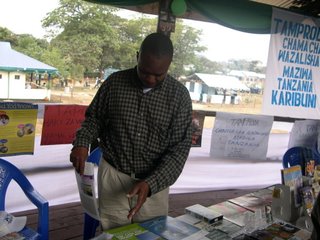



Maonyesho ya sikukuu ya wakulima Kitaifa 2006 yalifanyika mkoani arusha Katika viwanja vya Themi njiro, TAPO tulishiriki kikamilfu katika kuelimisha jamii kuhusiana na masula mbalimbali yanayohusu haki za wanyama na viumbe wote kwa ujumla, lengo letu lilikuwa kuelimisha na wala siyo kufanya biashara kama washiriki wengine walivyofanya.
Friday, July 21, 2006
Kunguru
KUNGURU
Kunguru wa Zanzibar
Jina la kisayansi anajulikana Kama “corvus splendens”
Historia yake katika Tanzania:
Kunguru hawa Kwa mara ya kwanza walipelekwa katika visiwa vya Zanzibar kutoka katika mji wa Bombay na serikali ya India mwaka 1891 mara baada ya kuombwa na Sir Gerald portal. Waliletwa kunguru 50 Kwa ajili ya kudhibiti uchafu na takataka zinazoweza kuliwa na ndege hawa katika sehemu ijulikanayo kama “Stone Town.”
Ulipofika mwaka 1917 uzalianaji wa kunguru uliongezeka sana na kufanya waonekane kama ndege waharibifu sehemu ya stone town. Kunguru Siyo tu wanadhibiti takataka zinazooza tu, Bali pia wanakula wanyama wadogowadogo (Kama panya), mazao ya mbegu, matunda na mazao mengine.
Lakini pia kunguru wanashindana na aina nyingi za viumbe tofauti kwa chakula. na katika sehemu za viota vya ndege moja kwa moja wanakula vifaranga na mayai kutoka kwa ndege wengine. Huu ni ukweli kuwa sehemu ambayo wanapatikana kunguru, ndege wametengeneza viota sehemu ambayo kunguru hatofikia, na siyo rahisi kukuta ndege amejenga kiota kwenye mti, tofauti na sehemu ambayo hakuna kunguru utakuta ndege wamejenga kiota kwenye miti na sehemu nyingine ya wazi kabisa.
Utambuzi
Kuna aina sita (6) ya kunguru duniani, na kunguru ni huyu wa Zanzibar ndiye kunguru mdogo kuliko wengine katika jamii Yao [sm 43]. Ana rangi nyeusi ikitapakaa sehemu kubwa ya mwili na rangi ya majivu kwenye shingo na kifuani, wana macho ya kahawia wakiwa wakubwa.
Vifaranga vya kunguru vinafafana na kunguru wakubwa, lakini wana macho meusi na mdomo wa ndani huwa unakuwa na rangi ya pink.
Chakula chao
Kunguru wana aina nyingi ya chakula,
Chakula chao ni pamoja na:
Mbegu- karanga, mahindi nk
Matunda
Wadudu
Wanyama wadogo wadogo
Mayai
Mizoga, nk.
Uzaaji wao.
Kunguru ni jamii ya ndege, na hutengeneza kiota kikubwa kilicho na umbile kama la bakuli, kwa kutumia vijiti, majani, magome ya miti na manyoya. Kiota hujegwa kwa ushirikiano wa kunguru dume na jike, mayai hulaliwa na jike tu, na kifaranga mmoja huzaliwa kwa mwaka, kifaranga hulishwa na dume na jike
Kusambaa Kwa kunguru.
Kutokana na jinsi kunguru wanavyozaliana kwa wingi na upatikanaji wa chakula chao kwa urahisi, ndivyo polepole wanavyozidi kutapakaa sehemu tofauti za nchi ya Tanzania. Kwa mfano, mkoani Morogoro utaona kunguru mmoja mmoja katika manispaa ya morogoro, lakini baada ya miaka michache watakuwa wengi Sana. na inasadikika kuwa kutokana na kunguru kuweza kuishi kwenye hali ya hewa tofauti, basi katika miaka ijayo Mikoa yote ya Tanzania watapatikana.
Kunguru wa Zanzibar
Jina la kisayansi anajulikana Kama “corvus splendens”
Historia yake katika Tanzania:
Kunguru hawa Kwa mara ya kwanza walipelekwa katika visiwa vya Zanzibar kutoka katika mji wa Bombay na serikali ya India mwaka 1891 mara baada ya kuombwa na Sir Gerald portal. Waliletwa kunguru 50 Kwa ajili ya kudhibiti uchafu na takataka zinazoweza kuliwa na ndege hawa katika sehemu ijulikanayo kama “Stone Town.”
Ulipofika mwaka 1917 uzalianaji wa kunguru uliongezeka sana na kufanya waonekane kama ndege waharibifu sehemu ya stone town. Kunguru Siyo tu wanadhibiti takataka zinazooza tu, Bali pia wanakula wanyama wadogowadogo (Kama panya), mazao ya mbegu, matunda na mazao mengine.
Lakini pia kunguru wanashindana na aina nyingi za viumbe tofauti kwa chakula. na katika sehemu za viota vya ndege moja kwa moja wanakula vifaranga na mayai kutoka kwa ndege wengine. Huu ni ukweli kuwa sehemu ambayo wanapatikana kunguru, ndege wametengeneza viota sehemu ambayo kunguru hatofikia, na siyo rahisi kukuta ndege amejenga kiota kwenye mti, tofauti na sehemu ambayo hakuna kunguru utakuta ndege wamejenga kiota kwenye miti na sehemu nyingine ya wazi kabisa.
Utambuzi
Kuna aina sita (6) ya kunguru duniani, na kunguru ni huyu wa Zanzibar ndiye kunguru mdogo kuliko wengine katika jamii Yao [sm 43]. Ana rangi nyeusi ikitapakaa sehemu kubwa ya mwili na rangi ya majivu kwenye shingo na kifuani, wana macho ya kahawia wakiwa wakubwa.
Vifaranga vya kunguru vinafafana na kunguru wakubwa, lakini wana macho meusi na mdomo wa ndani huwa unakuwa na rangi ya pink.
Chakula chao
Kunguru wana aina nyingi ya chakula,
Chakula chao ni pamoja na:
Mbegu- karanga, mahindi nk
Matunda
Wadudu
Wanyama wadogo wadogo
Mayai
Mizoga, nk.
Uzaaji wao.
Kunguru ni jamii ya ndege, na hutengeneza kiota kikubwa kilicho na umbile kama la bakuli, kwa kutumia vijiti, majani, magome ya miti na manyoya. Kiota hujegwa kwa ushirikiano wa kunguru dume na jike, mayai hulaliwa na jike tu, na kifaranga mmoja huzaliwa kwa mwaka, kifaranga hulishwa na dume na jike
Kusambaa Kwa kunguru.
Kutokana na jinsi kunguru wanavyozaliana kwa wingi na upatikanaji wa chakula chao kwa urahisi, ndivyo polepole wanavyozidi kutapakaa sehemu tofauti za nchi ya Tanzania. Kwa mfano, mkoani Morogoro utaona kunguru mmoja mmoja katika manispaa ya morogoro, lakini baada ya miaka michache watakuwa wengi Sana. na inasadikika kuwa kutokana na kunguru kuweza kuishi kwenye hali ya hewa tofauti, basi katika miaka ijayo Mikoa yote ya Tanzania watapatikana.
Wednesday, July 19, 2006
International Day of Action for Korean Dogs and Cats
This year's global day of action, co-sponsored by Korean animal protection groups CARE and KAAP, will be held on July 20th, 2006, to coincide with the first of Korea's "Bok days" (literally, the hot, dog days of summer). South Korea's dog meat consumption increases during this time of year because some superstitiously believe they can keep cool by eating animals who do not sweat.
Last year, IDA and AFK successfully organized activists from a dozen countries - including Argentina, Belgium, Canada, Columbia, Ireland, Mexico, Peru, Russia, South Korea, Spain and Tanzania - for this international day of protest. In the U.S., demonstrators converged on Korean consulates and embassies in New York City; Washington, D.C.; Atlanta, Ga.; San Francisco and Los Angeles, Calif.; and Portland, Ore. to oppose the illegal eating of cats and dogs in South Korea.
The international press covered the protests favorably in several newspapers and online news websites. In Seoul, South Korea, dozens of protestors rallied the public against dog and cat consumption with colorful signs, costumes and inventive tactics like locking themselves in small cages dressed as dogs. In San Francisco, 20 people came to IDA's protest at the Korean Consulate and a good number brought their companion dogs to be ambassadors for their exploited canine cousins in Korea. In the few short weeks leading up to the demonstration, activists collected over 5,000 petition signatures, which were presented to the Korean Consulate at the protest.
Last year, IDA and AFK successfully organized activists from a dozen countries - including Argentina, Belgium, Canada, Columbia, Ireland, Mexico, Peru, Russia, South Korea, Spain and Tanzania - for this international day of protest. In the U.S., demonstrators converged on Korean consulates and embassies in New York City; Washington, D.C.; Atlanta, Ga.; San Francisco and Los Angeles, Calif.; and Portland, Ore. to oppose the illegal eating of cats and dogs in South Korea.
The international press covered the protests favorably in several newspapers and online news websites. In Seoul, South Korea, dozens of protestors rallied the public against dog and cat consumption with colorful signs, costumes and inventive tactics like locking themselves in small cages dressed as dogs. In San Francisco, 20 people came to IDA's protest at the Korean Consulate and a good number brought their companion dogs to be ambassadors for their exploited canine cousins in Korea. In the few short weeks leading up to the demonstration, activists collected over 5,000 petition signatures, which were presented to the Korean Consulate at the protest.
Tuesday, July 18, 2006
TWIGA
TWIGA
Twiga: Giraffe: Giraffe Camelopardalis
Wanapatikana: Africa, Kusini mwa jangwa la Sahara, kwenye miti ya
Wazi Na kwenye majani.
Urefu mpaka mapembe: Dume, mita 4.7-5.3, jike mita 3.94-5
Uzito: Dume, kilo 800- 1930, jike, kilo 550-1180
Tabia: Wanajitenga kimakundi
Umri wa kuishi: Miaka 25 wakiwa porini
Chakula chao: Majani kutoka juu ya miti, majani ya kwenye vichaka,
Mizizi nk.
Sauti: Kawaida huwa kimya, lakini wanapiga chafya, mtoto hulia
Kama atachanganyikiwa.
Kuna subspecies tisa za twiga zinazotambulika, zote zinafanana lakini zinatofautiana kwa michirizi ya rangi, na mgawanyiko wa kijiografia.
Twiga ni viumbe wastaarabu, lakini hawajiweki kwenye makundi, badala yake wanakutana kimakundi kila siku, lakini mchanganyiko wa kundi unatofautiana kila siku baada siku. Twiga dume wa sehemu Fulani huwa anaanzisha hali ya kusachi kwa kurefusha shingo.Iwapo dume mgeni ataingia makazi ya dume mwingine atafukuzwa na dume lenye makazi yake, na wote wawili watagombana kwa kugonganisha vichwa vyao mpaka mmoja wao atakaposhindwa. Fuvu la dume twiga ni gumu zaidi kwa sababu hiyo.
Uzaaji: kubalehe Kwa twiga jike Ni kati ya miezi 48-60, twiga dume Ni miezi 42. Twiga wanapandana wakati wowote Kwa mwaka Na mimba kubebwa kati ya siku 450-464. Huwa kunakuwa Na mtoto mmoja anayezaliwa, mapacha ni adimu kuzaliwa.
Twiga jike katika msimu huwatamanisha madume yaliyo karibu naye, lakini Ni dume mkumbwa tu ndiye anayeshinda. Dume lililoshinda huwafukuza madume wadogo Kwa kuwatisha: kupigana, siyo lazima katika hali hii. Mimba ya twiga huishia miezi 15 baada ya hapo huzaa Na mama Na mtoto wa twiga watakwenda sehemu au uwanja wa ushirikiano unaotumiwa Na majike muda kwa muda na mtoto wake tu hapo. Watoto wa twiga wanazaliwa Na mapembe, ambayo siyo kawaida. Mapembe yanalala kwenye fuvu la mtoto wakati wa kuzaliwa, lakini yatajinyoosha mara baada ya wiki kwanza kuzaliwa .
Uwanja wa kutunzia watoto huwa kuna kuwa na mtoto mdogo wa twiga kila mara ataachwa na watoto wenzie wenye kufikia umri sawa wakati mama yake atakapo kwenda kutafuta chakula wakati katikati ya siku. Hata hivyo watoto wa twiga wanawindwa Sana na fisi, chui na mbwa mwitu, na ni nusu yao ndio tu watakao pona katika muda wa miezi sita ya kwanza.
Jinsi mtoto anavyokuwa mkubwa atajiunga na mama kwenda kutafuta chakula. Simba ndio adui Yao mkubwa, lakini twiga anauwezo wa kumuua simba iwapo Kama atamsukuma kwa nguvu kwa kutumia miguu yake ya mbele. Baada ya watoto wa twiga kufikisha umri wa mwaka mmoja ni wachache kati ya mmoja kwa kumi atakufa kwa mwaka.
Kujitegemea kwa twiga kunachukua miezi 15 ingawa mama yake atakutana tena na dume miezi 5 baada ya mtoto kuzaliwa, twiga kijana wa kike anakaa na mama yake, lakini twiga kijana wa kiume atakwenda kujiunga na umoja wa madume wote na kwenda kutembea peke yake atakapofikisha umri kiasi cha miaka 3.
Chakula: Twiga ni wanyama wanaokula majani na hula majani miti na vichaka. Wanatofautiana katika ukusanyaji wa chakula na kutegemea na nini anacho kula.
Baadhi ya miti Kama vile acacia, ina miba mingi Sana, hivyo twiga anahitaji kuwa makini wakati atakapokuwa ana kula chakula kutoka kwenye miti hiyo. Huwa wanamega majani na mikungu ya majani na kuwacha miiba pekee Yao. Ulimi wa twiga unaweza kufikia sm 45 kwa urefu, na hutumia kusukuma majani ndani ya mdomo na kupaka chakula chote kwa mate yanayovutika kufanya chakula kiwe rahisi kumeza.
Jinsi twiga wanavyotumia kutafuta na kukifikia chakula inapunguza ushindani katika jinsia. Twiga jike ana inama chini ili kufikia matawi ya majani ya chini na vichaka, lakini twiga dume anarefusha shingo yake kufikia majani ya juu ya miti. Twiga jike anakula mpaka kufikia masaa 12 katika kila masaa 24, lakini dume linakula muda mchache. Dume linakula kiasi cha kilo 60 za majani Kwa siku.
Uhifadhi wa twiga
Twiga ni mnyama aliye ma mvuto katika kumwangalia na hata jinsi anavyotembea kwa mwendo wa madaha kutokana na urefu wake ambapo kuanzaia kichwa, shingo, mwili na hata mguu inavyotingishika
Ili twiga na vizazi vyake vijavyo waweze kuishi pasipo bughudha ya binadamu popote pale ndani ya nchi ya Tanzania na majirani zake, tunahitaji kuwa na huruma na upendo na kuheshimu viumbe hawa kwa kuwasaidia kwa hali yeyote watakapo patwa na jambo lolote la kutishia uhai wao, ikiwa pamoja na kuzuia ujangili na uwindaji, utumiaji wa bidhaa zitokanazo na twiga, kuhifadhi na kulinda mazingira ya wanyama hawa wanayoishi, kama vile kutokuchoma moto mapori, kutupa kitu chochote kile kitakachowadhuru mwili na uhai wao kwa ujumla, na kuwalinda kutopata magonjwa.
Twiga: Giraffe: Giraffe Camelopardalis
Wanapatikana: Africa, Kusini mwa jangwa la Sahara, kwenye miti ya
Wazi Na kwenye majani.
Urefu mpaka mapembe: Dume, mita 4.7-5.3, jike mita 3.94-5
Uzito: Dume, kilo 800- 1930, jike, kilo 550-1180
Tabia: Wanajitenga kimakundi
Umri wa kuishi: Miaka 25 wakiwa porini
Chakula chao: Majani kutoka juu ya miti, majani ya kwenye vichaka,
Mizizi nk.
Sauti: Kawaida huwa kimya, lakini wanapiga chafya, mtoto hulia
Kama atachanganyikiwa.
Kuna subspecies tisa za twiga zinazotambulika, zote zinafanana lakini zinatofautiana kwa michirizi ya rangi, na mgawanyiko wa kijiografia.
Twiga ni viumbe wastaarabu, lakini hawajiweki kwenye makundi, badala yake wanakutana kimakundi kila siku, lakini mchanganyiko wa kundi unatofautiana kila siku baada siku. Twiga dume wa sehemu Fulani huwa anaanzisha hali ya kusachi kwa kurefusha shingo.Iwapo dume mgeni ataingia makazi ya dume mwingine atafukuzwa na dume lenye makazi yake, na wote wawili watagombana kwa kugonganisha vichwa vyao mpaka mmoja wao atakaposhindwa. Fuvu la dume twiga ni gumu zaidi kwa sababu hiyo.
Uzaaji: kubalehe Kwa twiga jike Ni kati ya miezi 48-60, twiga dume Ni miezi 42. Twiga wanapandana wakati wowote Kwa mwaka Na mimba kubebwa kati ya siku 450-464. Huwa kunakuwa Na mtoto mmoja anayezaliwa, mapacha ni adimu kuzaliwa.
Twiga jike katika msimu huwatamanisha madume yaliyo karibu naye, lakini Ni dume mkumbwa tu ndiye anayeshinda. Dume lililoshinda huwafukuza madume wadogo Kwa kuwatisha: kupigana, siyo lazima katika hali hii. Mimba ya twiga huishia miezi 15 baada ya hapo huzaa Na mama Na mtoto wa twiga watakwenda sehemu au uwanja wa ushirikiano unaotumiwa Na majike muda kwa muda na mtoto wake tu hapo. Watoto wa twiga wanazaliwa Na mapembe, ambayo siyo kawaida. Mapembe yanalala kwenye fuvu la mtoto wakati wa kuzaliwa, lakini yatajinyoosha mara baada ya wiki kwanza kuzaliwa .
Uwanja wa kutunzia watoto huwa kuna kuwa na mtoto mdogo wa twiga kila mara ataachwa na watoto wenzie wenye kufikia umri sawa wakati mama yake atakapo kwenda kutafuta chakula wakati katikati ya siku. Hata hivyo watoto wa twiga wanawindwa Sana na fisi, chui na mbwa mwitu, na ni nusu yao ndio tu watakao pona katika muda wa miezi sita ya kwanza.
Jinsi mtoto anavyokuwa mkubwa atajiunga na mama kwenda kutafuta chakula. Simba ndio adui Yao mkubwa, lakini twiga anauwezo wa kumuua simba iwapo Kama atamsukuma kwa nguvu kwa kutumia miguu yake ya mbele. Baada ya watoto wa twiga kufikisha umri wa mwaka mmoja ni wachache kati ya mmoja kwa kumi atakufa kwa mwaka.
Kujitegemea kwa twiga kunachukua miezi 15 ingawa mama yake atakutana tena na dume miezi 5 baada ya mtoto kuzaliwa, twiga kijana wa kike anakaa na mama yake, lakini twiga kijana wa kiume atakwenda kujiunga na umoja wa madume wote na kwenda kutembea peke yake atakapofikisha umri kiasi cha miaka 3.
Chakula: Twiga ni wanyama wanaokula majani na hula majani miti na vichaka. Wanatofautiana katika ukusanyaji wa chakula na kutegemea na nini anacho kula.
Baadhi ya miti Kama vile acacia, ina miba mingi Sana, hivyo twiga anahitaji kuwa makini wakati atakapokuwa ana kula chakula kutoka kwenye miti hiyo. Huwa wanamega majani na mikungu ya majani na kuwacha miiba pekee Yao. Ulimi wa twiga unaweza kufikia sm 45 kwa urefu, na hutumia kusukuma majani ndani ya mdomo na kupaka chakula chote kwa mate yanayovutika kufanya chakula kiwe rahisi kumeza.
Jinsi twiga wanavyotumia kutafuta na kukifikia chakula inapunguza ushindani katika jinsia. Twiga jike ana inama chini ili kufikia matawi ya majani ya chini na vichaka, lakini twiga dume anarefusha shingo yake kufikia majani ya juu ya miti. Twiga jike anakula mpaka kufikia masaa 12 katika kila masaa 24, lakini dume linakula muda mchache. Dume linakula kiasi cha kilo 60 za majani Kwa siku.
Uhifadhi wa twiga
Twiga ni mnyama aliye ma mvuto katika kumwangalia na hata jinsi anavyotembea kwa mwendo wa madaha kutokana na urefu wake ambapo kuanzaia kichwa, shingo, mwili na hata mguu inavyotingishika
Ili twiga na vizazi vyake vijavyo waweze kuishi pasipo bughudha ya binadamu popote pale ndani ya nchi ya Tanzania na majirani zake, tunahitaji kuwa na huruma na upendo na kuheshimu viumbe hawa kwa kuwasaidia kwa hali yeyote watakapo patwa na jambo lolote la kutishia uhai wao, ikiwa pamoja na kuzuia ujangili na uwindaji, utumiaji wa bidhaa zitokanazo na twiga, kuhifadhi na kulinda mazingira ya wanyama hawa wanayoishi, kama vile kutokuchoma moto mapori, kutupa kitu chochote kile kitakachowadhuru mwili na uhai wao kwa ujumla, na kuwalinda kutopata magonjwa.
Wednesday, July 12, 2006
Hali Bora kwa Wanyama
HALI BORA KWA WANYAMA
Hali bora kwa Wanyama wanaotumiwa na Binadamu inatokana na jinsi ya kukubaliana na mfumo wa maisha bila ya kuteseka kwenye mazingira yaliyotayarishwa na binadamu.
Wanasayansi na Wanafilosofia wanatambua kuwa Wanyama wana akili ya kuendeshea maisha yao na hata hali ya mwili {afya na utambuzi wa mwili} ambavyo vinaweza kudhuliwa kwa jinsi gani Binadamu wanavyowatendea na kuwahifadhi.
Aina Tano za uhuru zinatumika kuelezea mahitaji yote ya Wanyama wa kufugwa na wajibu wa kuwatunza kama ifuatavyo;
Uhuru wa kutokuwa na maumivu, majeraha na magonjwa.
Uhuru wa kutokuwa na njaa, kiu, na utapiamlo.
Uhuru wa kuonyesha tabia ya kawaida.
Uhuru wa kutokutishwa na kutokusumbuliwa.
Uhuru wa kutokukosa raha ya mwili
Aina Tano za uhuru zinaweza kufikiwa kwa mfano,
Kuwatayari kuwapatia uwezekano wa maji safi ya kunywa, chakula bora cha kujenga afya ya mwili,na katika hali ambayo wanyma wamepewa chakula kwa kipimo, kufanya uwezekano wa kupatikana aina nyingine ya chakula kama vile majani ili kumridhisha mnyama
Kumpatia mazingira bora ambayo ni pamoja na kimvuli, nyumba ya kuishi, na sehemu nzuri ya kupumzikia.
Kuzuia na katambua haraka na kutibu magonjwa na majeraha, kumpatia chanjo pale inapobidi, kudhibiti mzunguko wa sehemu bora ya malisho ili kupunguza maambukizi ya magonjwa,
Mnyama apatiwe nusu kaputi haraka pale ambapo matibabu yataleta maumivu ya muda mrefu {kwa mfano kuvnjika kwa miguu}. Usimsafirishe mnyama mwenye majeraha au ugonjwa,au mnyama aliyefikia hatua za mwisho za ujauzito, labda iwe unampeleka kwa mganga wa mifugo au kwenye matibabu yenye faida kwa mnyama{kwamba usimsafirishe mnyama wa aina hiyo kwenye machinjio au sehemu myingine ambayo mwisho wake ni kuchinjwa }
Hali bora kwa Wanyama wanaotumiwa na Binadamu inatokana na jinsi ya kukubaliana na mfumo wa maisha bila ya kuteseka kwenye mazingira yaliyotayarishwa na binadamu.
Wanasayansi na Wanafilosofia wanatambua kuwa Wanyama wana akili ya kuendeshea maisha yao na hata hali ya mwili {afya na utambuzi wa mwili} ambavyo vinaweza kudhuliwa kwa jinsi gani Binadamu wanavyowatendea na kuwahifadhi.
Aina Tano za uhuru zinatumika kuelezea mahitaji yote ya Wanyama wa kufugwa na wajibu wa kuwatunza kama ifuatavyo;
Uhuru wa kutokuwa na maumivu, majeraha na magonjwa.
Uhuru wa kutokuwa na njaa, kiu, na utapiamlo.
Uhuru wa kuonyesha tabia ya kawaida.
Uhuru wa kutokutishwa na kutokusumbuliwa.
Uhuru wa kutokukosa raha ya mwili
Aina Tano za uhuru zinaweza kufikiwa kwa mfano,
Kuwatayari kuwapatia uwezekano wa maji safi ya kunywa, chakula bora cha kujenga afya ya mwili,na katika hali ambayo wanyma wamepewa chakula kwa kipimo, kufanya uwezekano wa kupatikana aina nyingine ya chakula kama vile majani ili kumridhisha mnyama
Kumpatia mazingira bora ambayo ni pamoja na kimvuli, nyumba ya kuishi, na sehemu nzuri ya kupumzikia.
Kuzuia na katambua haraka na kutibu magonjwa na majeraha, kumpatia chanjo pale inapobidi, kudhibiti mzunguko wa sehemu bora ya malisho ili kupunguza maambukizi ya magonjwa,
Mnyama apatiwe nusu kaputi haraka pale ambapo matibabu yataleta maumivu ya muda mrefu {kwa mfano kuvnjika kwa miguu}. Usimsafirishe mnyama mwenye majeraha au ugonjwa,au mnyama aliyefikia hatua za mwisho za ujauzito, labda iwe unampeleka kwa mganga wa mifugo au kwenye matibabu yenye faida kwa mnyama{kwamba usimsafirishe mnyama wa aina hiyo kwenye machinjio au sehemu myingine ambayo mwisho wake ni kuchinjwa }
Subscribe to:
Posts (Atom)






